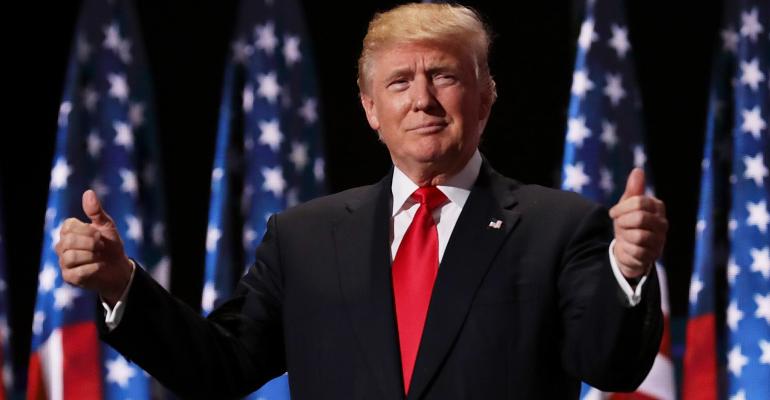By Mohamed A. El-Erian
(Bloomberg View) --In this period when markets are predominantly driven by policy, all it took were some signals from the White House for the major U.S. indexes to end last week at new highs and for the dollar to strengthen to levels not seen for months. Indeed, the currency has been on its longest daily winning streak since November. Moreover, with actual data suggesting the Federal Reserve is likely to hold off a March interest rate hike, Treasury yields were well behaved, addressing one of the investor concerns about the sustainability of the "Trump Rally."
The feel-good factor was not limited to the U.S. It spilled over to other stock markets around the world, taking some to levels not seen for quite a while. Even Europe rallied -- despite renewed concerns over Greek debt and a growing appreciation of the political risk associated with the French presidential election in April.
President Donald Trump's promise of "phenomenal" tax reform was an important contributor to last week's gains, but it was not the only one. Markets also took heart from the talks between the president and Prime Minister Shinzo Abe of Japan, who was on an official visit to the U.S. The conciliatory tone tempered general concerns about the risk of U.S. protectionism and global trade wars.
But rather than being viewed as a breakout to the upside, last week's stock gains are better thought of -- at least for now -- as part of the more volatile period for stocks in the post-Trump election era, or what I called in a Bloomberg View post the "third phase of the Trump Rally." Indeed, the up and down movements last week, including intraday, stood in contrast to the much narrower trading band that prevailed in the prior phase -- of consolidation between mid-December and the presidential inauguration -- and the overall gains were moderate relative to those of the first phase of the "Trump Rally" (from Trump's acceptance speech on Nov. 9 to mid- December).
With asset prices where they are now, the two competing sets of policy influences on stocks -- the set that theoretically offer the prospects of healthy reflation (such as tax reform, infrastructure and de-regulation) versus the one that would increase the risk of stagflation (particularly trade protectionism of the type that triggers retaliatory actions from other countries) -- are much more tenuously balanced now. As a result, any particular policy move is likely to have a more marked price impact. Also, after the president’s inauguration and his overall policy activism, it is getting harder to keep traders patient these days.
The next phase would most likely involve a break out, and it is subject to two qualifications regarding timing and direction, both of which have important political linkages.
Given political fluidity and the myriad of economic appointments and issues in play, it is hard to predict how long this phase will persist and how noisy it will be. The direction of the subsequent breakout is also hard to specify at this stage because of competing drivers that also extend beyond the U.S.
For the third phase of the "Trump Rally" to give way to another big and sustainable leg up in stocks and other risk assets, pro-growth policy announcements would need to give way to detailed careful design and, with the administration working collaboratively with Congress, sound implementation. There would also need to be policy improvements elsewhere -- particularly in China, Europe and Japan -- lest a consequential appreciation of the dollar pose a significant headwind to corporate performance and fuel protectionist forces within the U.S. By contrast, a slip by the U.S. into protectionist measures would likely fuel stagflationary tendencies, placing considerable downward pressures on stocks and other risk assets. These pressures would be particularly intense if accompanied by European political developments (such as the election of Marine Le Pen as president of France) that put in doubt the integrity and proper functioning of the euro zone.
This stark contrast -- or the "bipolar" world, as Larry Fink, the chief executive officer of the giant asset management firm BlackRock recently stated last week -- should not come as a large surprise. It is part of the more general phenomenon relating to a bimodal distribution of potential outcomes that I have discussed in prior columns and detailed in my book, "The Only Game in Town": The global economy and markets are in the process of transitioning away from a period anchored by three factors: first, global growth, while too low and insufficiently inclusive, was relatively stable; second, systemically-important central banks were both able and willing to repress financial volatility; and third, unusually fluid national and cross-border politics did not sway economic policies and developments in a major way, one way or the other.
This "new normal" world is coming to a gradual end. The process will be a more volatile one for markets as reflationary and stagflationary influences compete -- that is until it gives way to the breakout that is likely to follow.
This column does not necessarily reflect the opinion of the editorial board or Bloomberg LP and its owners.
Mohamed A. El-Erian is a Bloomberg View columnist. He is the chief economic adviser at Allianz SE and chairman of the President’s Global Development Council, and he was chief executive and co-chief investment officer of Pimco. His books include “The Only Game in Town: Central Banks, Instability and Avoiding the Next Collapse.”
To contact the author of this story: Mohamed A. El-Erian at [email protected] To contact the editor responsible for this story: Max Berley at [email protected]
For more columns from Bloomberg View, visit Bloomberg view





